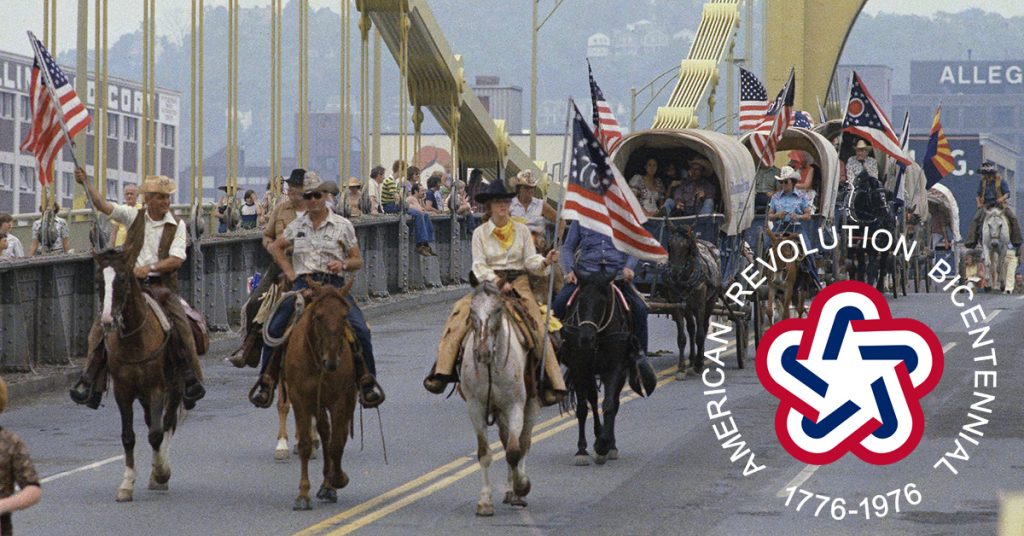
The 4th of July is always a special day in the United States, but 4th July1976 saw the party of a lifetime as the nation embarked upon the mother of all celebrations, to mark 200 years of independence.
The US Bicentennial, as two centuries of freedom following the Declaration of Independence of the United States of America became commonly known, was a wondrous, hugely patriotic event which lasted for longer than the year itself. Beginning in fact on 1st April 1975, when the American Freedom Train set off from Wilmington, Delaware on the first stage of its epic 25,000 mile, 21-month journey around each of the 48 contiguous states of the US. Later the same year the soon-to-be outgoing President Gerald Ford addressed the nation in commemoration of the historic battles of Concord and Lexington.
Of course, once 1976 did arrive there was to be no stopping this proud nation, which knows how to have a ball at the best of times. A tidal wave of glitz, pageantry and razzmatazz bedecked in red, white and blue poured out onto the streets, into the skies and around the ample waters which all but surround this vast, diverse and fascinating country. No expense was spared as fireworks, naval displays including an international flotilla of sailing ships, and a state visit by the Queen of Great Britain on the Royal Yacht Britannia with a symbolic presentation of the Bicentennial Bell, rang in the big event.
The land of the free and the home of the brave
But the US Bicentennial wasn’t just about the major national celebrations which dominated the news broadcasts and the TV channels. Its real strength lay in the input provided by families and households the length and breadth of the land, whose homespun contributions, even if modest by comparison, still stood tall before the eyes of the world. The land of the free and the home of the brave was two hundreds years old, and not in a bad place considering.
The recent history of the USA had been an eventful one to say the least. Having emerged from World War Two as the predominant western power, the country found itself in the position of leading the free world’s resistance to the designs of its rival superpower, the Soviet Union – which proved to be a mixed blessing. Costly wars had been fought in Korea and Vietnam, and proxy battles between pro-US and pro-Soviet forces in developing countries the world over had to be sustained. There had been an unsuccessful attempt to invade Cuba with a view to reversing a hostile revolution, and an ensuing missile crisis which had threatened to embroil the planet in a nuclear holocaust. Not long afterwards an elected US President had been cruelly assassinated in full public view. At the same time there had been successful space missions culminating in the moon landing and the “first small step for mankind” being taken by a US astronaut. America had been responsible for some of the most exciting developments in popular culture, and it had led the world in a new age of wealth and innovation.
This extraordinary young nation

The pride which filled the hearts of this extraordinary young nation and its people was always destined to find expression in the celebrations of the 200th anniversary of its creation. And to this day, recollections of those wonderful happenings and of the spirit which pervaded the land throughout the eternally memorable year that was 1976 are as vivid as they are many. Fire hydrants on sidewalks the length and breadth of the country were painted in the stars and stripes. Wherever one looked, Uncle Sam looked back in readiness and anticipation of any unexpected incendiary occurrence. Overseas National Airways kitted out two of its DC8 airliners in full patriotic regalia, appropriately registered N1776R and N1976P, the former displaying full Union colours and the latter showing the flag of the Confederacy. Parades, bands, films and other cultural events all seemingly morphed into one gigantic, year-long jamboree in which an endless conveyor belt of souvenirs and priceless mementos changed hands, everywhere and often.
The Magna Carta
Even outside of America, the spirit of the US Bicentennial did much to define the year. As well as the ceremonial gifting of a bell, the United Kingdom also loaned the US one of the two original copies of the Magna Carta, the royal charter of rights acceded to by King John in 1215 at Runnymede, at an international gathering of political leaders from both nations and from others at Westminster Hall. “What we are celebrating this year is not the severance of political links two centuries ago, but our common heritage of a living and evolving democracy and the rule of law,” said then British Prime Minister James Callaghan.
Not wanting to miss out on the commercial opportunities generated by the big bash across the pond, the English Tourist Board set about organising a series of walks and tours, taking visitors to places around the mother country which boasted American associations of any kind.
The US Bicentennial was an occasion unlike any other, giving the American people and others who wish them well a unique opportunity to showcase all that was good about life and the age in which they were living. Its magic reverberated far beyond the borders of the New World and, in a year that was already quite special, gave us all a reason to party.

If you enjoyed reading this article, make sure you stay updated with all Phil’s latest blog posts by signing up to receive his free Newsletter. You can unsubscribe at any time and your details will never be shared with any third party. Click here to sign up today.